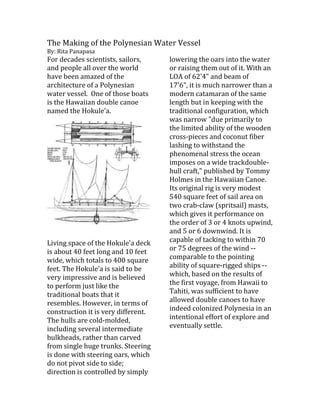
Polynesian navigation
- 1. The Making of the Polynesian Water Vessel By: Rita Panapasa For decades scientists, sailors, and people all over the world have been amazed of the architecture of a Polynesian water vessel. One of those boats is the Hawaiian double canoe named the Hokule’a. Living space of the Hokule’a deck is about 40 feet long and 10 feet wide, which totals to 400 square feet. The Hokule’a is said to be very impressive and is believed to perform just like the traditional boats that it resembles. However, in terms of construction it is very different. The hulls are cold-molded, including several intermediate bulkheads, rather than carved from single huge trunks. Steering is done with steering oars, which do not pivot side to side; direction is controlled by simply lowering the oars into the water or raising them out of it. With an LOA of 62'4" and beam of 17'6", it is much narrower than a modern catamaran of the same length but in keeping with the traditional configuration, which was narrow "due primarily to the limited ability of the wooden cross-pieces and coconut fiber lashing to withstand the phenomenal stress the ocean imposes on a wide trackdoublehull craft," published by Tommy Holmes in the Hawaiian Canoe. Its original rig is very modest 540 square feet of sail area on two crab-claw (spritsail) masts, which gives it performance on the order of 3 or 4 knots upwind, and 5 or 6 downwind. It is capable of tacking to within 70 or 75 degrees of the wind -comparable to the pointing ability of square-rigged ships -which, based on the results of the first voyage, from Hawaii to Tahiti, was sufficient to have allowed double canoes to have indeed colonized Polynesia in an intentional effort of explore and eventually settle.
